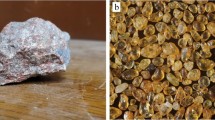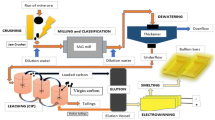Abstract
The beneficiation of platinum group metals (PGMs) from pristine (unweathered) sulfide ores has conventionally been conducted through froth flotation, which typically achieves platinum recoveries of over 85%. The achieved successes of PGM concentration by flotation from the pristine sulfide ores are largely due to the occurrence of PGMs in close association with base metal sulfide minerals like chalcopyrite, pentlantite, and pyrrhotite which are easily floatable. However, the fast depletion of sulfide PGM-bearing minerals has triggered interest in exploring the recovery of the PGMs from near-surface oxidized PGM ores which have proven to be more difficult to process by conventional means as an alternative source to sustain production of PGMs. Earlier attempts to process the oxidized PGM ores by conventional flotation methods achieved poor recoveries (typically less than 50%). The resource estimates of oxidized PGM ores which are either unmined, mined, and stockpiled or discarded as overburden waste in South Africa and Zimbabwe are over 500 million tonnes. The economic benefits that could be realized in the event of an alternative and effective processing technique being developed would be immense. This paper reviews and discusses different research efforts that have been made to improve PGM recoveries from oxidized ores, and their merits and demerits.









Similar content being viewed by others
References
Glaister BJ, Mudd GM (2010) The environmental costs of platinum–PGM mining and sustainability: is the glass half-full or half-empty? Miner Eng 23(5):438–450
Jones R (2005) An overview of Southern African PGM smelting. In: Donald J, Schonewille R (eds) Nickel and cobalt 2005: challenges in extraction and production. CIM, Montreal, pp 147–178
McGill JE (2010) Leading the next boom? Competitive eastern limb platinum supply. In: 4th International platinum conference: platinum in transition, Oct. 11–14 (Sun City)
Oberthür T, Melcher F, Buchholz P, Locmelis M (2013) The oxidized ores of the main sulphide zone, Great Dyke, Zimbabwe: turning resources into minable reserves-mineralogy is the key. South Afr Inst Min Metall 113(3):191–201
Rule C (1998) Hartley platinum mine metallurgical processing. In: Prendergast MD (Compiler) Guidebook, proc 8th int platinum symp, pre-symp excursion to the Great Dyke of Zimbabwe
Locmelis M, Melcher F, Oberthür T (2010) Platinum-group element distribution in the oxidized main sulfide zone, Great Dyke, Zimbabwe. Miner Deposita 45(1):93–109
Cramer LA (2001) The extractive metallurgy of South Africa’s platinum ores. JOM 53(10):14–18
Becker M, Wiese J, Ramonotsi M (2014) Investigation into the mineralogy and flotation performance of oxidised PGM ore. Miner Eng 65:24–32
Legrand D, Bancroft G, Nesbitt H (2005) Oxidation/alteration of pentlandite and pyrrhotite surfaces at pH 9.3: part 1. Assignment of XPS spectra and chemical trends. Am Miner 90(7):1042–1054
Buckley AN, Woods R (1984) An X-ray photoelectron spectroscopic study of the oxidation of chalcopyrite. Aust J Chem 37(12):2403–2413
Mielczarski J, Cases J, Alnot M, Ehrhardt J (1996) XPS characterization of chalcopyrite, tetrahedrite, and tennantite surface products after different conditioning. 1. Aqueous solution at pH 10. Langmuir 12(10):2519–2530
Vaughan D, Becker U, Wright K (1997) Sulphide mineral surfaces: theory and experiment. Int J Miner Process 51(1–4):1–14
Lagrand DL, Bancroft GM, Nesbitt HW (2005) Oxidation of pentlandite and pyrrhotite surfaces at pH 9.3: part 2. Effect of xanthates and dissolved oxygen. Am Miner 90(7):1055–1061
Evans D (2002) Potential for bulk mining of oxidized platinum-group element deposits. Appl Earth Sci 111(1):81–86
Hey P (1999) The effects of weathering on the UG2 Chromitite reef of the Bushveld complex, with special. S Afr J Geol 102(3):251–260
Mphela N (2010) Fundamental studies of the electrochemical and flotation behaviour of pyrrhotite. Dissertation (MEng), University of Pretoria, Pretoria
Ramonotsi M (2011) Characterisation of the effect of alteration on the PPM platinum ore and evaluation of selected strategies to improve metallurgical performance. Masters thesis, University of Cape Town, Cape Town
Luszczkiewicz A, Chmielewski T (2008) Acid treatment of copper sulfide middlings and rougher concentrates in the flotation circuit of carbonate ores. Int J Miner Process 88(1):45–52
Gorman J, Pagel R, Nenniger E (1976) Preleaching zinc concentrates at AMAX’s Sauget refinery. Eng Min J 177(8):65–69
Szolomicki Z (1995) Chemical treatment of zinc concentrate. In: I International conference of mineral processing, Zakopane (Poland), vol 14
Smithson E, John C, Rea T, Mwenya W (1991) Improving concentrate quality in the concentrators of Zambia Consolidated Copper Mines Limited using column cells. In: Column 91, international conference on column flotation, vol 2
Orwe D, Grano S, Lauder D (1998) Increasing fine copper recovery at the Ok Tedi concentrator, Papua New Guinea. Miner Eng 11(2):171–187
Castro S, Goldfarb J, Laskowski J (1974) Sulphidizing reactions in the flotation of oxidized copper minerals, I. Chemical factors in the sulphidization of copper oxide. Int J Miner Process 1(2):141–149
Jones M, Woodcock J (1978) Optimization and control of laboratory sulphidization of oxidized copper ores with an ion selective electrode. Miner Eng 6:11–19
Wills BA, Napier-Munn T (2006) Mineral processing technology: an introduction to the practical aspects of ore treatment and mineral recovery. Elsevier Science & Technology Books, Maryland Heights, MO
Freeman W, Newell R, Quast K (2000) Effect of grinding media and NaHS on copper recovery at Northparkes Mines. Miner Eng 13(13):1395–1403
Kongolo K, Kipoka M, Minanga K, Mpoyo M (2003) Improving the efficiency of oxide copper–cobalt ores flotation by combination of sulphidisers. Miner Eng 16(10):1023–1026
Newell A, Bradshaw D (2007) The development of a sulfidisation technique to restore the flotation of oxidised pentlandite. Miner Eng 20(10):1039–1046
Newell A, Bradshaw D, Harris P (2006) The effect of heavy oxidation upon flotation and potential remedies for Merensky type sulfides. Miner Eng 19(6):675–686
Musonda KJ (2015) Ammonia leaching as a pre-treatment for the processing of oxidised PGM ores. Masters dissertation, University of Cape Town, Cape Town
Bulatovic S (2003) Evaluation of alternative reagent schemes for the flotation of platinum group minerals from various ores. Miner Eng 16(10):931–939
Assis S, Montenegro L, Peres A (1996) Utilisation of hydroxamates in minerals froth flotation. Miner Eng 9(1):103–114
Lee J, Nagaraj D, Coe J (1998) Practical aspects of oxide copper recovery with alkyl hydroxamates. Miner Eng 11(10):929–939
Lee K, Archibald D, McLean J, Reuter M (2009) Flotation of mixed copper oxide and sulphide minerals with xanthate and hydroxamate collectors. Miner Eng 22(4):395–401
Prasad M, Mensah-Biney R, Pizarro R (1991) Modern trends in gold processing—overview. Miner Eng 4(12):1257–1277
Mwase JM, Petersen J, Eksteen J (2012) A conceptual flowsheet for heap leaching of platinum group metals (PGMs) from a low-grade ore concentrate. Hydrometallurgy 111:129–135
Chen J, Huang K (2006) A new technique for extraction of platinum group metals by pressure cyanidation. Hydrometallurgy 82(3):164–171
Green B, Smit D, Maumela H, Coetzer G (2004) Leaching and recovery of platinum group metals from UG-2 concentrates. J S Afr Inst Min Metall 104(6):323–331
Van Wyk AP (2014) Flowsheet development and comparison for the recovery of precious metals from Cyanide Leach Solutions. Masters Dissertation, Stellenbosch University, Cape Town
Radmehr V, Koleini SM, Khalesi MR, Tavakoli MR (2012) Ammonia leaching in the copper industry: a review. In: XXVI international mineral processing congress (IMPC) proceedings/New Delhi, India/24–28 September, pp 02512–02523
Muzawazi C, Petersen J (2015) Heap and tank leaching of copper and nickel from a Platreef flotation concentrate using ammoniacal solutions. Can Metall Q 54(3):297–304
Bruckard W, McDonald K, McInnes C, Sparrow G, Woodlock J (1992) Platinum, palladium, and gold extraction from Coronation Hill ore by cyanidation at elevated temperatures. Hydrometallurgy 30(1):211–227
Becker K, Wotruba H (2008) Aufbereitung von PGE-Oxiderzen. Bundesanstalt für Geowissenschaften und Rohstoffe. Berichte Zur Lagerstätten-Und Rohstoffforschung 54: 30
Kraemer D, Junge M, Oberthür T, Bau M (2015) Improving recoveries of platinum and palladium from oxidized Platinum-Group Element ores of the Great Dyke, Zimbabwe, using the biogenic siderophore Desferrioxamine B. Hydrometallurgy 152:169–177
Mohwinkel D, Bau M (2012) Siderophore-enhanced extraction of Pt from oxidised PGE ores from the Great Dyke, Zimbabwe. In: European mineralogical conference
Duyvesteyn S, Liu H, Duyvesteyn W (1994) Recovery of platinum group metals from oxide ores—TML process. Hydrometallurgy’94. Springer, Dordrecht, pp 887–912
Torres R, Lapidus GT (2016) Platinum, palladium and gold leaching from magnetite ore with concentrated chloride solutions and ozone. Hydrometallurgy 166:184–194
Mpinga C, Eksteen J, Aldrich C, Dyer L (2015) Direct leach approaches to Platinum Group Metal (PGM) ores and concentrates: a review. Miner Eng 78:93–113
Shaik K, Petersen J (2017) An investigation of the leaching of Pt and Pd from cooperate, sperrylite and column bioleached concentrates in thiocyanate-cyanide systems. Hydrometallurgy 173:210–217
Petersen J, Muzawazi C, Mwase J, Jones G (2013) Ammonia leaching of chalcopyrite in low grade ores—a fresh perspective? In: Copper 2013: proceedings of the copper international conference, Santiago, Chile 1–4 December 2013. The Chilean Institute of Mining Engineers (IIMCH), pp 67–78
Mwase J, Petersen J (2017) Characterizing the leaching of sperrylite (PtAs2) in cyanide-based solutions. Hydrometallurgy 172:1–10
Author information
Authors and Affiliations
Corresponding author
Ethics declarations
Conflict of interest
The authors declare that they have no conflict of interest.
Additional information
The contributing editor for this article was T. Hirato.
Rights and permissions
About this article
Cite this article
Sefako, R., Sekgarametso, K. & Sibanda, V. Potential Processing Routes for Recovery of Platinum Group Metals from Southern African Oxidized PGM Ores: A Review. J. Sustain. Metall. 3, 797–807 (2017). https://doi.org/10.1007/s40831-017-0146-0
Published:
Issue Date:
DOI: https://doi.org/10.1007/s40831-017-0146-0




